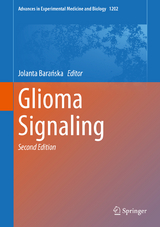Glioma Signaling
Springer (Verlag)
978-94-007-4718-0 (ISBN)
- Titel erscheint in neuer Auflage
- Artikel merken
1. INTRODUCTION TO PURINERGIC SIGNALING IN THE BRAIN
Geoffrey Burnstock
Abstract
1.1 Introduction
1.2 Purinergic Signalling in the CNS
1.2.1 Cotransmission
1.2.2 Glial Cells
1.2.3 Neuron-Glial Interactions
1.3 Purinergic Signalling in Normal Behaviour
1.4 Purinergic Pathophysiology in the CNS, including Gliomas
References
2. ADENOSINE SIGNALING IN GLIOMA CELLS
Stefania Ceruti and Maria P. Abbracchio
Abstract
2.1 Introduction
2.2 Adenosine Metabolism and P1 Adenosine Receptors
2.3 A Role for Ecto-5’-Nucleotidases CD39 and CD73 in Gliomas?
2.4 Receptor-Mediated Effects of Adenosine on Glioma Cell Growth and Survival
2.4.1 A1-, A2A-, and A2B-Mediated Effects on Glioma Cells
2.4.2 The A3 Receptor Subtype as a New Pharmacological Ttarget for Innovative Chemotherapic Approaches to Gliomas
2.5 Receptor-Idependent Effects of Adenosine Analogues on Glioma Cell Growth and Survival
2.6 Conclusions and Future Perspectives
References
3. CROSS-TALK IN NUCLEOTIDE SIGNALING IN GLIOMA C6 CELLS
Dorota Wypych and Jolanta Barańska
Abstract
3.1 Introduction
3.2 Properties of P2 Receptors
3.2.1 P2X Receptors
3.2.2 P2Y Receptors
3.3 P2Y1, P2Y2 and P2Y12 Rreceptor Expression and Functionality in Rat Glioma C6 cells
3.4 Serum Withdrawal
3.4.1 Effect on P2Y1 and P2Y12 Receptor Expression
3.4.2 Effect on C6 cell Morphology, Growth and Differentiation
3.4.3 Effect on the P2Y14 Receptor
3.5 Cyclic AMP Effect on Cell Proliferation, Growth and Differentiation
3.6 Effect of Extracellular Nucleotides on ERK1/2 and PI3K/Akt Activity: P2Y1 and P2Y12 Cross-Talk.
3.7 The P2X7 Receptor
3.8 Concluding Remarks
References
4. CALCIUM SIGNALING IN GLIOMA CELLS – THE ROLE OF NUCLEOTIDE RECEPTORS
Dorota Wypych and Pawel Pomorski
Abstract
4.1 Origin of the Calcium Signaling
4.2 Sources of the Calcium Signal
4.2.1 Extracellular Calcium Signal
4.2.2 Signal Generated by Calcium Stores
4.2.2.1 Store Operated Calcium Signaling
4.2.2.2 Calcium-Induced Calcium Signaling
4.3 Calcium Signaling in Non-Excitable Glial Cells
4.3.1 Astrocytes
4.3.2 Microglia
4.4 Nucleotide Receptors-Evoked Calcium Signaling in Glial Cells
4.5 Glioma C6: a Case Study
4.5.1 The Nature of the Signal – the Role of Nucleotide Receptors in Glioma C6 Cells
4.6 Gliomas: The Motile Tumors, Calcium Signaling and Chemotaxis
4.6.1 The Calcium Signal in Glioma C6 is Strongly Dependent on Actin Cytoskeleton
4.7 Concluding Remarks
References
5. PURINERGIC SIGNALING IN GLIOMA PROGRESSION
Elizandra Braganhol, Márcia Rosângela Wink, Guido Lenz and Ana Maria Oliveira Battastini
Abstract
5.1 Introduction
5.1.1 Molecular and Cellular Origins of Gliomas
5.1.2 Glioma Cancer Stem Cells (CSCs)
5.1.3 Tumor Microenvironment – Key for Understanding and Targeting Gliomas
5.2 Purinergic Signaling in Gliomas
5.3 Ectonucleotidases
5.3.1 Ectonucleoside Triphosphate Diphosphohydrolases (E-NTPDases)
5.3.2 Ectonucleotide Pyrophosphatase/Phosphodiesterases (E-NPPs)
5.3.3 Ecto-Alkaline Phosphatases (ALP)
5.3.4 Ecto-5’-Nucleotidase (ecto-5’-NT/CD73)
5.4 Ecto-adenosine Deaminase (ecto-ADA)
5.5 Other Ecto-Nucleotide Metabolizing Enzymes
5.6 Ectonucleotidases in Gliomas
5.7 The Purinergic Hypothesis of Glioma Invasion
References
6. CYTOSKELETON AND NUCLEOTIDE SIGNALING IN GLIOMA CELLS
Wanda Kłopocka, Jarosław Korczyński and Pawel Pomorski
Abstract
6.1 Introduction
6.2 The Role of P2Y2 Receptor in Actin Cytoskeleton Organization
6.2.1 Regulation by PIP2
6.2.2 Regulation by the Small GTP-binding Proteins: Rho, Rac and Cdc42
6.3 Compensation of ROCK Inhibition by P2Y2 Activated Signaling Pathways
6.3.1 ROCK Inhibition in Glioma C6 Cells
6.3.2 Effect of P2Y2 Receptor Stimulation on MLC Phosphorylation – the Role of MLCK
6.3.3 Effect of P2Y2 Receptor Stimulation on Cofilin Phosphorylation – the Role of Rac1 Protein
6.3.4 Effect of Calcium Signal on Glioma C6 Cells Recovery from ROCK Inhibition - Essential Role of Integrins
6.4 Summary
References
7. SIGNALING DETERMINANTS OF GLIOMA CELL INVASION
Aneta Kwiatkowska and Marc Symons
Abstract
7.1 Invasiveness of Glioma Cells
7.2 Factors that Control Glioma Invasion.
7.2.1 Autocrine Factors.
7.2.2 Paracrine Factors.
7.3 Signaling Mechanisms that Control Glioma Invasion.
7.3.1 Integrins
7.3.2 Rho GTPases
7.3.3 PI3K and Phospholipid Signaling
7.3.4 Akt Kinase
7.4 Proteases
7.5 Conclusions and Future Directions
References
8. RECEPTOR TYROSINE KINASES: PRINCIPLES AND FUNCTIONS IN GLIOMA INVASION
Mitsutoshi Nakada, Daisuke Kita, Lei Teng, Ilya V. Pyko, Takuya Watanabe and Jun-ichiro Hamada
Abstract
8.1 Introduction
8.2 EGFR/EGF
8.3 PDGFR/PDGF
8.4 ERBB2
8.5 c-Met/HGF
8.6 Tie/Ang
8.7 Axl/Gas6
8.8 DDR1/Collagen
8.9 Eph/Ephrin
8.10 TrkA
8.11 Cross-Talk
8.12 Targeting Receptor Type Tyrosine Kinases
8.12.1 Targeting EGFR
8.12.2 Targeting PDGFR
8.12.3 Multiple Kinase Inhibitors
8.13 Prospective
References
9. TGF BETA SIGNALING AND ITS ROLE IN GLIOMA PATHOGENESIS
Bozena Kaminska and Magdalena Kijowska
Abstract
9.1 Introduction
9.2 A Brief Summary of Mechanisms of TGF-b Signaling in Normal and Malignant Cells
9.2.1 Components and Mechanisms of TGF-b Signaling
9.2.2 Negative Regulators of TGF-b Signaling 9.2.3 Transcriptional Responses Induced by TGF-b Signaling.
9.3 Deregulation of TGF-b Signaling in Gliomas.
9.4 Functions of TGF-b Signaling in Glioma Biology
9.4.1 TGF-b Signaling in Controlling Cell Proliferation
9.4.2 TGF-b Signaling in the Regulation of Invasion
9.4.3 TGF-β1 as Pro-Angiogenic Factor
9.4.4 A Role of TGF-b Signaling in Glioma Cancer Initiating Cells
9.4.5. TGF-b Signaling in Tumor-Mediated Immunosuppression
9.5 Molecular and Pharmacological Strategies to Interfere with TGF-b Signaling for Potential Therapeutic Intervention in Gliomas
References
10. STAT signaling in glioma cells
Karolina Swiatek-Machado and Bozena Kaminska
Abstract
10.1 Introduction
10.2 A Brief Summary of Mechanisms of STAT Activation in Normal and Malignant Signaling
10.2.1 Mechanisms of STAT Activation
10.2.2 Negative Regulators of STAT Signaling
10.2.3 Transcriptional Targets of STATs
10.3 Dysfunction of STAT Signaling in Gliomas
10.3.1 Constitutive Activation of STAT3 in Gliomas
10.3.2 STAT3 Activation in Gliomas Results from Dysfunction in Control Mechanisms
10.4 Functions of STAT3 in Gliomas
10.4.1 STAT3 as an Oncogene
10.4.2 STAT3 as a Tumor Suppressor
10.4.3 STAT3 in Glioma Cancer Initiating Cells
10.5 Molecular and Pharmacological Strategies to Interfere with STAT Signaling for Potential Therapeutic Intervention in Gliomas
References
11. CANNABINOID SIGNALING IN GLIOMA CELLS
Aleksandra Ellert-Miklaszewska, Iwona Ciechomska and Bozena Kaminska
Abstract
11.1 Introduction
11.2 Cannabinoids and their Receptors
11.3 Cannabinoid System in Gliomas
11.4 Action of Cannabinoids in Glioma Cells
11.4.1 Mechanism of Cannabinoids Pro-Apoptotic Action – Inhibition of Pro-Survival Pathways
11.4.2 The Role of ER Stress and Autophagy in Cannabinoid-Induced Cell Death
11.5 Therapeutic Potential of Targeting Cannabinoid Signaling in Gliomas
References
| Reihe/Serie | Advances in Experimental Medicine and Biology ; 986 |
|---|---|
| Zusatzinfo | 7 Tables, black and white; X, 227 p. |
| Verlagsort | Dordrecht |
| Sprache | englisch |
| Maße | 178 x 254 mm |
| Gewicht | 672 g |
| Themenwelt | Medizin / Pharmazie ► Medizinische Fachgebiete ► Neurologie |
| Medizin / Pharmazie ► Medizinische Fachgebiete ► Onkologie | |
| Medizin / Pharmazie ► Studium | |
| Naturwissenschaften ► Biologie ► Zoologie | |
| Schlagworte | gliomas signaling • nucleotide receptors • tumor growth • tumor invasion • tyrosine kinase receptors |
| ISBN-10 | 94-007-4718-7 / 9400747187 |
| ISBN-13 | 978-94-007-4718-0 / 9789400747180 |
| Zustand | Neuware |
| Haben Sie eine Frage zum Produkt? |
aus dem Bereich





